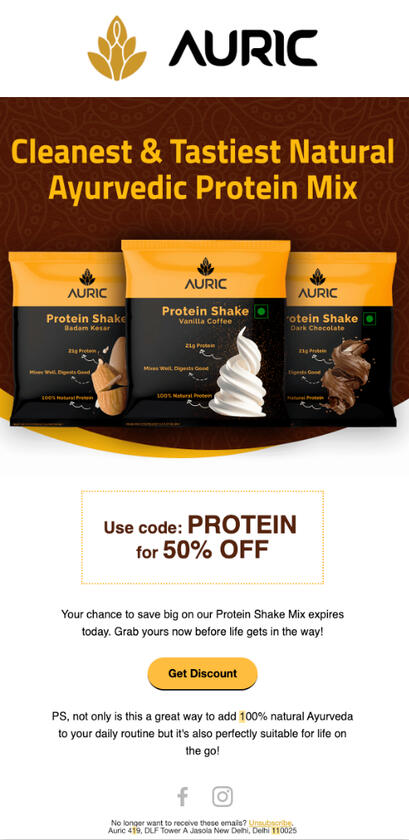Automation:
eCommerce Marketing:
The Perfect Product Page
Too often, eCommerce brands don't have fully optimized product pages and make the same common mistakes:
Unclear messaging for 1st time visitors.
Important information is hidden in the 'About Us' page, forcing people to open up several tabs to manually search for info that's required for them to consider a purchase.
No comparisons of similar products which leaves visitors confused about what's a better or worse choice for them.
Listing tons of product features, but failing to tie them back to what those features mean for the end user.
Highlighting benefits of the product, but neglecting to mention how those benefits vary according to various use cases.
Not showing the popup secondarily on product pages with unique configuration, which makes people leave to open a new window or search for codes on coupon sites.
eCommerce Companies
Increase subscriber revenue by 10%+ in 7 days by aligning signup forms & product pages to the customer journey. No hidden or additional costs!
The Problem?
Most forms cause unnecessary friction & do not show at times most likely to influence a purchase
Most product pages lack the context required to help someone make a decision
When the customer journey is misaligned with the company journey
Many brands only track opt-in rate but never look at subscriber-purchase-rate
The Solution?
Use forms that 1) improve the customer journey and 2) increase conversions across product pages
Data-Driven eCommerce
Improve marketing
Offset CAC
Convert more visitors
Identify growth opportunities
Why is Zero Party Data Important for eCommerce Brands?
The best way to convert more visitors is to collect data that sheds a light on why purchases occur with regards to their customer journey & unique buying characteristics.Marketing is increasingly competitive, costs of goods & advertising are increasing, limited tracking... Data is what sets brands apart.Much of the inefficiency in eCommerce stems from marketers measuring success based on skewed metrics:
The revenue shown in your klaviyo dashboard does not accurately represent email-generated revenue. It shows email-attributed revenue which takes credit for sales that would have happened anyways. Putting an extra touchpoint in front of latent sales is not "generative".
ROAS is not an accurate measure of an ad's success. This is due to the fact that the true return on ad spend is realized outside of a 1:1 timeframe, but ROAS is measured within a 1:1 timeframe so it cannot measure for that; it only gives you part of the picture... For example; 2 people come through the same ad, at the same AOV, and the same ROAS... Which person is more likely to come back and purchase a 2nd time? In-platform ROAS cannot tell you that...
Sitewide A/B tests don't provide clean data. Audience Quality varies across the website. A/B tests should hold the audience that's being tested on consistent in order to reduce variables that skew outputs.
How is Zero Party Data Used for eCommerce Growth?
Data is collected, analyzed, and leveraged across all the customer journey's touchpoints. Zero Party Data is the #1 way to understand the quality of your audience and gain context for the characteristics comprising them.It's used to identify the returns ads generate outside of the time frames for which dashboards measure.It's used to send personalized emails during times that email. marketing is most likely to influence a sale.It's used to highlight top-converting features, use cases, & previously hidden context across product pages.It's used to understand what is & isn't working at each touchpoint throughout the customer journey.Pre-Purchase Qualitative data combined with Post-Purchase Quantitative data is an awesome way to identify growth opportunities with less wasted spend and testing.
Email Marketing for eCommerce
Campaigns
Flows
List Growth
Reduce your email marketing workload by 50% while improving performance
Retention is a co-opted term in the context of eCommerce. Email & SMS marketing do not generate 20-30% of a brand's revenue, but rather takes credit for 20-30% of their revenue based on last click attribution.Marketers have zero control over customer retention.Retention is the result of product need + timing of need for the product + perceived value. If someone doesn't need what you sell, an email won't change their mind.The whole point of email marketing is to reach people during times most likely to influence a purchase according to their buying. Confidence Intervals around average time to and between purchases are the best way to define time periods where your marketing is most likley to influence a conversion.
Email Marketing Examples:
eCommerce Brand Reviews
Video reviews analyzing:
Signup forms
Product pages
New visitor's experience in real time
Go-to-market strategies
@CandidCommerce is a YouTube channel I started to post video reviews of ecom brands that caught my attention or that I've personally ordered from in the past. My goal for these reviews is two-fold: 1) highlight cool companies and 2) provide actionable tips from the POV of the customer journey.
My Podcast:

























